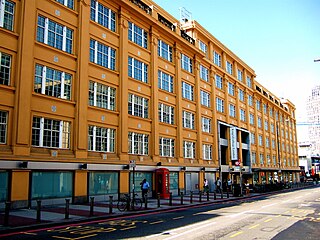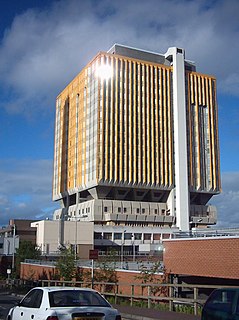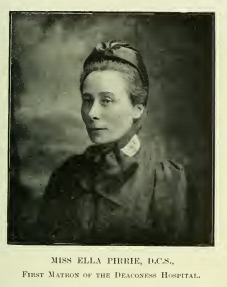Related Research Articles

Florence Nightingale was an English social reformer, statistician and the founder of modern nursing. Nightingale came to prominence while serving as a manager and trainer of nurses during the Crimean War, in which she organised care for wounded soldiers at Constantinople. She significantly reduced death rates by improving hygiene and living standards. Nightingale gave nursing a favourable reputation and became an icon of Victorian culture, especially in the persona of "The Lady with the Lamp" making rounds of wounded soldiers at night.

The Liverpool Royal Infirmary was a hospital in Pembroke Place in Liverpool, England. The building is now used by the University of Liverpool.

The Florence Nightingale Faculty of Nursing, Midwifery & Palliative Care is an academic faculty within King's College London. The faculty is the world's first nursing school to be continuously connected to a fully serving hospital and medical school. Established on 9 July 1860 by Florence Nightingale, the founder of modern nursing, it was a model for many similar training schools through the UK, Commonwealth and other countries for the latter half of the 19th century. It is primarily concerned with the education of people to become nurses and midwives. It also carries out nursing research, continuing professional development and postgraduate programmes. The Faculty forms part of the Waterloo campus on the South Bank of the River Thames and is now one of the largest faculties in the university.

Ethel Gordon Fenwick was a British nurse who played a major role in the History of Nursing in the United Kingdom. She campaigned to procure a nationally recognised certificate for nursing, to safeguard the title "Nurse", and lobbied Parliament to pass a law to control nursing and limit it to "registered" nurses only.
Sir Douglas Strutt Galton was a British engineer. He became a captain in the Royal Engineers and Secretary to the Railway Department, Board of Trade. In 1866 he was a member of the Royal Commission on Railways. From 1869 to 1875 he was Directory of Public Works and Buildings.

The Belfast City Hospital in Belfast, Northern Ireland, is a 900-bed modern university teaching hospital providing local acute services and key regional specialities. Its distinctive orange tower block dominates the Belfast skyline being the third tallest storeyed building in Ireland. It has a focus on the development of regional cancer and renal services. It is managed by Belfast Health and Social Care Trust and is the largest general hospital in the United Kingdom. In April 2020, due to the global coronavirus pandemic, the tower block was designated one of the UK's Nightingale Hospitals.
Lucy Osburn was an English nurse trained at the School of Nursing founded by Florence Nightingale. She is regarded as the founder of modern nursing in Australia.

Agnes Elizabeth Jones of Fahan, County Donegal, Ireland became the first trained Nursing Superintendent of Liverpool Workhouse Infirmary. She gave all her time and energy to her patients and died at the age of 35 from typhus fever. Florence Nightingale said of Agnes Elizabeth Jones, ‘She overworked as others underwork. I looked upon hers as one of the most valuable lives in England.’
Florence Sarah Lees was one of the English pioneers of district nursing.
The history of nursing in the United Kingdom relates to the development of the profession since the 1850s. The history of nursing itself dates back to ancient history, when the sick were cared for in temples and places of worship. In the early Christian era, nursing in the United Kingdom was undertaken by certain women in the Christian Church, their services being extended to patients in their homes. These women had no real training by today's standards, but experience taught them valuable skills, especially in the use of herbs and folk drugs, and some gained fame as the physicians of their era. Remnants of the religious nature of nurses remains in Britain today, especially with the retention of the job title "Sister" for a senior female nurse.
Beatrice Isabel Jones, was a British nurse who, after serving in several civilian hospitals, volunteered for military service. She served in the Second Boer War in South Africa and then later served during the First World War in Baghdad as matron-in-chief of Mesopotamia. She was one of the inaugural recipients of the Florence Nightingale Medal.

Highgate Hospital was a name used to refer to the infirmary building which opened in 1869 on the St Pancras side of Dartmouth Park Hill in Highgate, London.
Rebecca Strong was an English nurse who pioneered preliminary training for nurses.

Brownlow Hill infirmary was a large workhouse infirmary in Liverpool, notable for its role in advancing training of nurses. The workhouse was demolished in 1931, and the site is now occupied by Liverpool's Catholic cathedral.
The Association for the Improvement of the Infirmaries of London Workhouses was established on 3 March 1866 at a public meeting organised by Joseph Rogers, and Drs. Hart, Anstie and Carr of the Lancet. It was chaired by Henry Herbert, 4th Earl of Carnarvon. Charles Dickens and John Stuart Mill were present. It campaigned for the provision of six Poor Law hospitals in London of one thousand beds each, with trained nurses, resident medical officers, and medicines financed from the rates. Carnarvon denounced the dreadful and disgraceful conditions in workhouse infirmaries and the guardians responsible for them. He helped to pass the Poor Law Amendment Act 1867.
Workhouse infirmaries were established in the nineteenth century in England. They developed from the Workhouse and were run under the Poor law regime.

Miss Isabella "Ella" Barbour Pirrie, DCS (1857–1929), was the first nurse in the Belfast Union Workhouse Infirmary, establishing a nursing school there. She went on to become the first matron at the Deaconess Hospital, Edinburgh, established by Archibald Charteris as a training school for nurses.

Dulwich Community Hospital was a hospital located in Dulwich, London. It was replaced by a modern health centre on the same site in April 2020.

The statue of Mary Seacole stands in the grounds of St Thomas' Hospital, Lambeth, London. Sculpted by Martin Jennings, the statue was executed in 2016. It honours Mary Seacole, a British-Jamaican who established a "British Hotel" during the Crimean War and who was posthumously voted first in a poll of "100 Great Black Britons".
References
- ↑ Higginbottom, Peter (2012). Workhouse Encyclopaedia. History Press. ISBN 978-0752477190 . Retrieved 6 June 2017.
- ↑ "Workhouse Nursing Association" (PDF). British Journal of Nursing. 21 March 1914. Retrieved 6 June 2017.
- ↑ Abel-Smith, Brian (1960). A History of the Nursing Profession. London: Heinemann. p. 47.
- ↑ "Famous Londoners – Florence Nightingale…". Exploring London. Retrieved 6 June 2017.